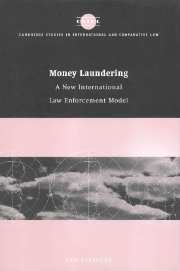Book contents
- Frontmatter
- Contents
- Preface
- Table of treaties and agreements
- List of abbreviations
- Part I New instruments in the fight against acquisitive crime: confiscation of proceeds from crime and criminalisation of money laundering
- Part II The prevention of money laundering
- Part III Jurisdiction over money laundering
- Part IV International co-operation in combating money laundering
- Epilogue
- Bibliography
- Index
- CAMBRIDGE STUDIES IN INTERNATIONAL AND COMPARATIVE LAW
Epilogue
The Fight Against Money Laundering, Goals and Effectiveness
Published online by Cambridge University Press: 16 October 2009
- Frontmatter
- Contents
- Preface
- Table of treaties and agreements
- List of abbreviations
- Part I New instruments in the fight against acquisitive crime: confiscation of proceeds from crime and criminalisation of money laundering
- Part II The prevention of money laundering
- Part III Jurisdiction over money laundering
- Part IV International co-operation in combating money laundering
- Epilogue
- Bibliography
- Index
- CAMBRIDGE STUDIES IN INTERNATIONAL AND COMPARATIVE LAW
Summary
At the end of this book on the international fight against money laundering, it seems appropriate to assess the effectiveness of the fight. But before attempting to assess the effectiveness of the international anti-money laundering regime, it is, of course, necessary to spell out its goals. These are, however, not clearly delineated. Though the various purposes that are served by the fight against money laundering were discussed in Chapter 1, it is far from clear which of these purposes are pursued by policy-makers either on an international or on a domestic level. Nevertheless, it is above all necessary to distinguish between the ultimate goals and the intermediate purposes that are served by the fight against money laundering. A number of the goals that have been set by various national and international authorities in the context of combating money laundering are in fact only means to an end, intermediate goals that it is necessary to reach before attaining an ultimate, final goal. Sometimes, those involved in the fight against money laundering have lost sight of this essential distinction. Thus, it seems that American law enforcement authorities are sometimes tempted to consider the seizure and forfeiture of assets as the primary goal of the fight against money laundering, in the attainment of which any means is justified, whereas it is only an intermediate goal subsidiary to reaching the ultimate goal of reducing crime. In the same vein, compliance by financial institutions with anti-money laundering rules has sometimes been looked on as an end in itself, whereas it is in fact no more than a means of providing law enforcement authorities with useful information and protecting the financial industry from criminal influence.
- Type
- Chapter
- Information
- Money LaunderingA New International Law Enforcement Model, pp. 420 - 431Publisher: Cambridge University PressPrint publication year: 2000

